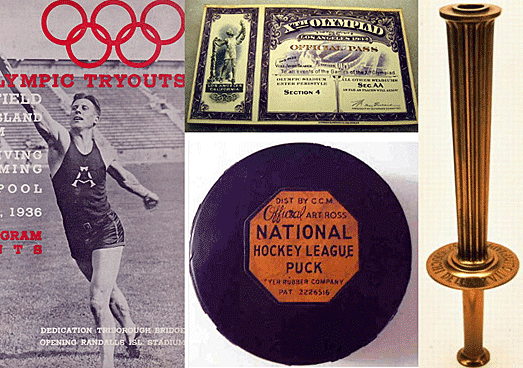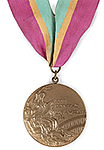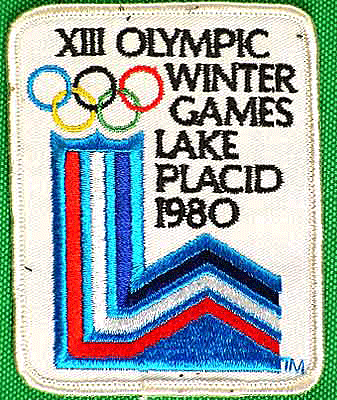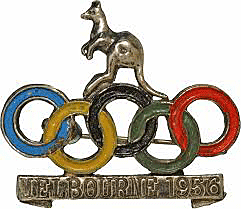|
Going for the Gold
by Bob Brooke
While millions of people from all over the world
watch the Parade of Nations into the Olympic Stadium in order to see
their country's representatives, just as many collectors eagerly await
the flood of Olympic collectibles that will be made available once the
games have begun.

When the Olympics role around, many people think of pins. But true
collectors look for all the other memorabilia produced by the games.
This involves everything that has to do with the games, from press
passes to Olympic torches.
But the items collectors seek most are those used by the athletes,
judges, and coaches, as well as those that bear an athlete’s likeness.
 Many
consider Olympic pins to be the low-end items in the realm of Olympic
collectibles. The premier items are the torches carried from Athens,
Greece, to the destination of the Olympics that year and everywhere in
between. Originally a runner with a torch ran around the country of
Greece to announce the Olympic games were soon going to take place. The
torch runner was sort of a town crier. Many
consider Olympic pins to be the low-end items in the realm of Olympic
collectibles. The premier items are the torches carried from Athens,
Greece, to the destination of the Olympics that year and everywhere in
between. Originally a runner with a torch ran around the country of
Greece to announce the Olympic games were soon going to take place. The
torch runner was sort of a town crier.
The first torch run of the modern games took place in Germany in 1936
when the games were held in Berlin. The first Olympic flame had been lit
in 1928 in Amsterdam, but prior to 1936 there had never been a relay of
runners who brought the flame directly from Greece to that year's
Olympic Games site.
While there have always been multiple torches used during this run,
Olympic torches are hard to find, especially if a collector is trying to
acquire one of only three torches used at the Oslo Games, for example.
One Oslo torch sold for $27,000. More recent games, like the ones in
Atlanta in 1996, produce thousands of torches. Even so, a torch from the
Atlanta Games sells for about $2,500.
 So
what else is there to collect from the Olympic Games? Medals.
Unfortunately, athletes do sell their medals, especially those from
Eastern European countries. Most of the time they do so to raise money
because many don’t go on to sports fame and fortune sponsoring products. So
what else is there to collect from the Olympic Games? Medals.
Unfortunately, athletes do sell their medals, especially those from
Eastern European countries. Most of the time they do so to raise money
because many don’t go on to sports fame and fortune sponsoring products.
After watching an athlete struggle to win a gold medal, it’s hard to
believe that they would part with it. Take U.S. sprinter Jesse Owens.
Regardless that he made Adloph Hitler lose face at the 1926 Berlin
Olympics by garnering the gold, Owens was never able to cash in on his
triumph once back in the states. He actually ended up working as a
janitor for the Cleveland Public Schools and was so strapped for money
that he did indeed sell his Olympic medals in order to make ends meet.
Besides the medals athletes actually win, every athlete who participates
in an Olympic Games receives a participation medal. If an athlete is
fortunate enough to place first through sixth in an event, he or she
also receives a winner's certificate. These types of items are
collectible as are programs, tickets, beer steins and souvenir
figurines.
 Olympic
badges are another hot item. The International Olympic Committee (IOC)
gave badges to athletes and officials until 1972. These badges admitted
them into various Olympic venues, like the Olympic village or into
sports arenas. The badges are very militaristic looking. Each shows
which sport an athlete or official participated in. Members of the media
also received badges to admit them to whatever sports competition they
were covering. A badge given to media to cover the first winter Olympics
in Chamonix, France, in 1924, for example, sold for $5,000. Typically,
media badges, depending on which Olympics they’re for, can sell for
anywhere from $100 to $500. Olympic
badges are another hot item. The International Olympic Committee (IOC)
gave badges to athletes and officials until 1972. These badges admitted
them into various Olympic venues, like the Olympic village or into
sports arenas. The badges are very militaristic looking. Each shows
which sport an athlete or official participated in. Members of the media
also received badges to admit them to whatever sports competition they
were covering. A badge given to media to cover the first winter Olympics
in Chamonix, France, in 1924, for example, sold for $5,000. Typically,
media badges, depending on which Olympics they’re for, can sell for
anywhere from $100 to $500.
 Some
collectors seek official Olympic reports, which tell how well the games
were run, the attendance at each event, what went wrong, and such,
published after the completion of the games. Other collectible items
include architectural plans for the stadiums and Olympic posters
promoting the events, such as the Art Deco ones from the 1920s, which
can sell for $2,000 to $5,000. The same goes for banners, flags, and
stuffed mascots. Some
collectors seek official Olympic reports, which tell how well the games
were run, the attendance at each event, what went wrong, and such,
published after the completion of the games. Other collectible items
include architectural plans for the stadiums and Olympic posters
promoting the events, such as the Art Deco ones from the 1920s, which
can sell for $2,000 to $5,000. The same goes for banners, flags, and
stuffed mascots.
Some Olympic Games produced items that are more desirable than others.
The 1904 Games, held in St. Louis in conjunction with the World's Fair,
had the lowest number of participating athletes, most of which were from
the U.S. The fair was the primary event, eclipsing the Games, so not
many other countries sent athletes. Needless to say, there are very few
items around from this event.
The next Olympics, held in 1906, as a sort of interim event, that was
put on in order to restore interest in the Olympic Games. While this
1906 event wasn’t officially recognized by the IOC as having been a true
Olympics, items from it are still sought by collectors.
 And
while Olympic pins may not have the pinache of other items, collecting
them is easy because so many are available. Collecting pins has grown
tremendously since the 1984 Summer Olympics in Los Angeles. Since then,
collectors’ clubs and newsletters have sprung up all over the country. And
while Olympic pins may not have the pinache of other items, collecting
them is easy because so many are available. Collecting pins has grown
tremendously since the 1984 Summer Olympics in Los Angeles. Since then,
collectors’ clubs and newsletters have sprung up all over the country.
The value of an item really depends on the athlete associated with it,
whether he or she used it or their likeness is on it. Prices of
participation medals, for instance, can range from $150 to $19,000.
 With
Olympic collectibles, the range is so wide that anyone on any budget can
afford to start a collection. It all began with the 1896 Olympic Games
in Athens, the first held in the modern era, and a menu from the IOC
dinner. Olympic stamps, issued to help raise money to balance the budget
for those games, also appeared. Both of these items started people
collecting Olympic memorabilia, something that has continued to the
present day. With
Olympic collectibles, the range is so wide that anyone on any budget can
afford to start a collection. It all began with the 1896 Olympic Games
in Athens, the first held in the modern era, and a menu from the IOC
dinner. Olympic stamps, issued to help raise money to balance the budget
for those games, also appeared. Both of these items started people
collecting Olympic memorabilia, something that has continued to the
present day.
To read
more of my articles, please
visit
my Web site.
< Back
to Collectibles Archives
Next Article >
|
